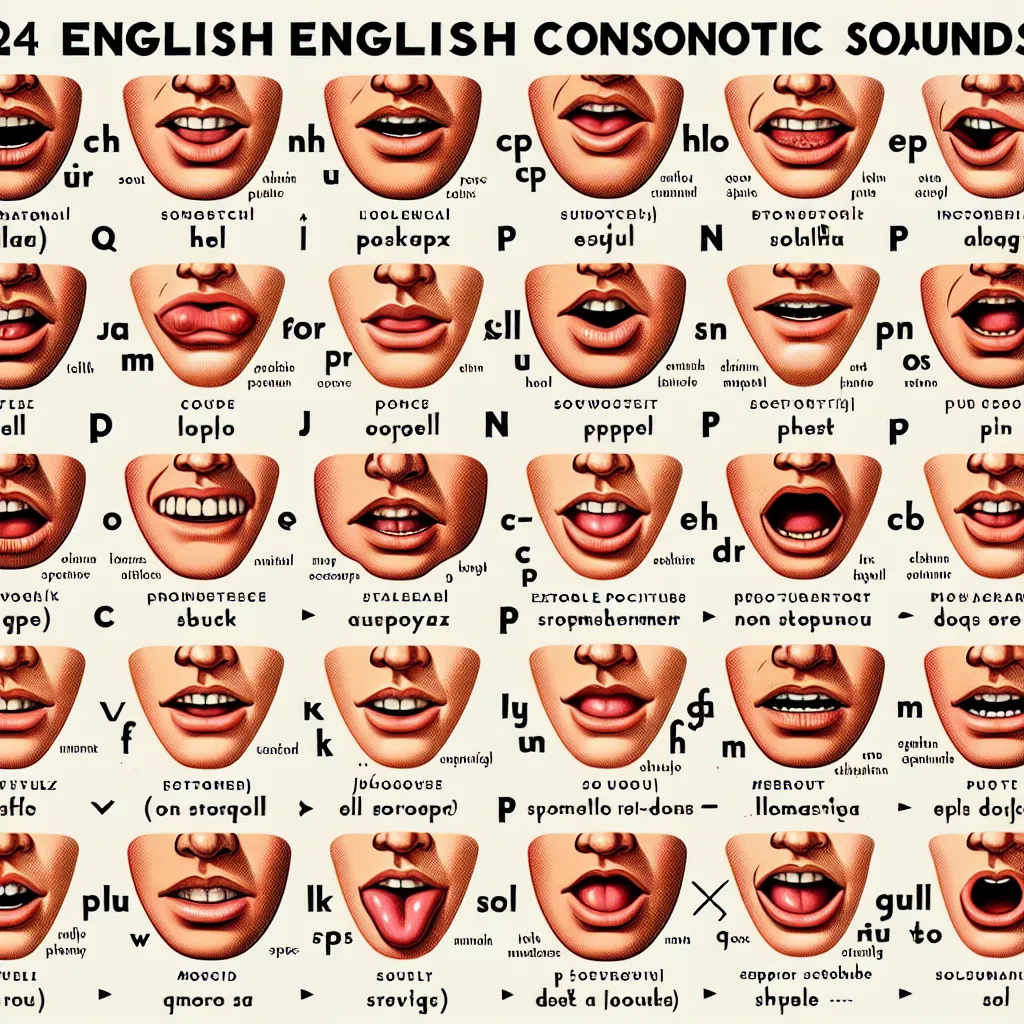English pronunciation can be challenging, especially when it comes to consonant sounds that may not exist in your native language. This guide will help you master those tricky consonant sounds and improve your overall English pronunciation.
Understanding Consonant Sounds in English
Consonant sounds are the building blocks of English pronunciation. They are produced by obstructing or constricting the flow of air through the vocal tract. English has 24 consonant sounds, some of which can be particularly difficult for non-native speakers.
 English Consonant Sounds Chart
English Consonant Sounds Chart
Why Consonant Sounds Matter
Mastering consonant sounds is crucial for clear and effective communication in English. Mispronouncing these sounds can lead to misunderstandings or make your speech difficult to comprehend. For example, the difference between “think” and “sink” lies solely in the initial consonant sound.
Common Difficult Consonant Sounds
Let’s explore some of the most challenging consonant sounds for English learners and how to pronounce them correctly.
The ‘th’ Sounds
English has two ‘th’ sounds: voiced (/ð/) as in “this” and unvoiced (/θ/) as in “think.”
To produce these sounds:
- Place the tip of your tongue between your upper and lower front teeth.
- For the voiced /ð/, vibrate your vocal cords while pushing air out.
- For the unvoiced /θ/, simply push air out without vibrating your vocal cords.
Practice with these words: this, that, think, three, breathe, teeth
The ‘r’ Sound
The English ‘r’ sound (/r/) can be challenging for speakers of many languages.
To produce this sound:
- Curl the tip of your tongue back towards the roof of your mouth.
- The sides of your tongue should touch your upper back teeth.
- Round your lips slightly.
Practice with these words: red, run, arrow, carry, room, very
The ‘l’ Sound
The ‘l’ sound (/l/) can be tricky, especially at the end of words.
To produce this sound:
- Touch the tip of your tongue to the ridge behind your upper front teeth.
- Allow air to flow around the sides of your tongue.
Practice with these words: light, love, fall, middle, bottle, animal
Techniques for Improving Consonant Pronunciation
Mirror Practice
Use a mirror to observe your mouth and tongue positions when practicing difficult sounds. This visual feedback can help you make necessary adjustments.
Minimal Pairs Practice
Work with minimal pairs – words that differ by only one sound. For example:
- think / sink
- van / ban
- light / right
Practice distinguishing and producing these pairs to improve your pronunciation accuracy.
Tongue Twisters
Tongue twisters are an excellent way to practice difficult consonant sounds. Try these:
- “The thirty-three thieves thought that they thrilled the throne throughout Thursday.”
- “Red lorry, yellow lorry.”
- “Peter Piper picked a peck of pickled peppers.”
Start slowly and gradually increase your speed as you become more comfortable.
 Tongue Twisters for Pronunciation Practice
Tongue Twisters for Pronunciation Practice
Listen and Repeat
Expose yourself to native English speakers through podcasts, videos, or language exchange partners. Listen carefully to how they pronounce difficult consonant sounds and try to mimic them.
Common Pronunciation Errors and How to Fix Them
- Substituting ‘f’ or ‘s’ for ‘th’: Focus on placing your tongue between your teeth for ‘th’ sounds.
- Rolling the ‘r’: Practice the curled tongue position without vibrating your tongue.
- Omitting final consonants: Exaggerate the final sounds when practicing to build muscle memory.
The International Phonetic Alphabet (IPA) and Difficult Consonants
Learning the International Phonetic Alphabet can greatly aid in mastering difficult consonant sounds. Here are some key IPA symbols for challenging English consonants:
- /θ/ – unvoiced ‘th’ as in “think”
- /ð/ – voiced ‘th’ as in “this”
- /r/ – ‘r’ sound as in “red”
- /l/ – ‘l’ sound as in “light”
- /ŋ/ – ‘ng’ sound as in “sing”
Familiarizing yourself with these symbols can help you understand the correct pronunciation when using dictionaries or language learning resources.
Top 10 Commonly Mispronounced Words with Difficult Consonants
- Clothes (/kloʊðz/)
- Thirds (/θɜːrdz/)
- Rural (/ˈrʊrəl/)
- World (/wɜːrld/)
- Squirrel (/ˈskwɜːrəl/)
- Thrilled (/θrɪld/)
- Rhythm (/ˈrɪðəm/)
- Lethargic (/ləˈθɑːrdʒɪk/)
- Twelfth (/twelfθ/)
- Zephyr (/ˈzefər/)
Practice these words regularly to improve your pronunciation of difficult consonant sounds.
Conclusion
Mastering difficult consonant sounds in English takes time and practice, but it’s an essential step towards clear and effective communication. Remember to be patient with yourself and celebrate small improvements. Regular practice using the techniques outlined in this guide will help you make significant progress in your English pronunciation journey.
For more tips on improving your English pronunciation, check out our related articles on pronunciation tips for effective communication and how to master English pronunciation with drills.
Keep practicing, and don’t hesitate to ask questions or share your experiences in the comments below. Happy learning!




